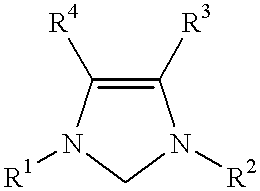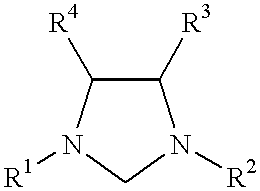Use of a catalyst system comprising nickel, palladium, or platinum and imidazoline-2-ylidene or imidazolidine-2-ylidene in kumada coupling reactions
a technology of kumada coupling reaction and catalyst system, which is applied in the preparation of amino compounds, physical/chemical process catalysts, organic compounds/hydrides/coordination complex catalysts, etc., can solve the problems of inability to employ aryl chlorides as feedstock for chemical transformation, requiring the use of more expensive aryl bromides and aryl iodides, and achieving excellent yields
- Summary
- Abstract
- Description
- Claims
- Application Information
AI Technical Summary
Benefits of technology
Problems solved by technology
Method used
Image
Examples
example 1
For each run, a Schlenk tube was charged with Pd.sub.2 (dibenzylideneacetone).sub.3 (10 mg, 0.01 mmol), 1,3-bis(substituted)imidazolinium chloride (0.04 mmol), and a magnetic stirring bar. After a 30 minute catalyst activation period, solvent (5 mL), 4-chlorotoluene (1.0 mmol), and phenylmagnesium bromide (1.2 mmol) were added in turn to the Schlenk tube. The Schlenk tube was placed in an oil bath and the mixture was heated and stirred for a number of hours. The mixture was then allowed to cool to room temperature. The mixture was hydrolyzed either with aqueous HCl (1.0 moles per liter) or H.sub.4 NCl solution. The solvent was removed under vacuum and the residue was purified by flash chromatography using hexane or a mixture of hexane and ethyl acetate.
The 1,3-bis(substituted)imidazolinium chloride used in each run are listed in Table 1. All of the yields reported in Table 1 are of the heterocoupling product, and are the average of two runs.
example 2
Reagents, analyses, and procedures were as described in Example 1, except as follows. In all runs, the solvent was a mixture of 1,4-dioxane and tetrahydrofuran; the 1,3-bis(substituted)imidazolinium chloride used was 1,3-bis(2,6-diisopropylphenyl)imidazolinium chloride. All runs were performed at 80.degree. C. Several different aryl halides (1.0 mmol each) and Grignard reagents (1.2 mmol each) were used. In Run B, Pd(CH.sub.3 CO.sub.2).sub.2 (4.5 mg, 0.02 mmol) was used as the metal compound; in Run F, 1.8 mmol of the Grignard reagent was used, and in Runs H and I, 2.5 mmol of the Grignard reagent was used.
The aryl halides and Grignard reagents used in each run are listed in Table 2. All of the yields reported in Table 2 are of the heterocoupling product, and are the average of two runs.
example 3
Reagents, analyses, and procedures were as described in Example 1, except as follows. In all runs, the Pd.sub.2 (dibenzylideneacetone).sub.3 was used in the amount of 0.02 mmol; the solvent was 1,4-dioxane; the 1,3-bis(substituted)imidazolinium chloride used was 1,3-bis(2,6-diisopropylphenyl)imidazolinium chloride in the amount of 0.02 mmol. All runs were performed at 80.degree. C. for 48 hours. Several different aryl chlorides (1.0 mmol each) and Grignard reagents (1.2 mmol each) were used.
The aryl chlorides and Grignard reagents used in each run are listed in Table 3. All of the yields reported in Table 3 are of the heterocoupling product, and are the average of two runs.
Example 4
Reagents, analyses, and procedures were as described in Example 1, except as follows. In all runs, the Pd.sub.2 (dibenzylideneacetone).sub.3 was used in the amount of 0.02 mmol; the solvent was 1,4-dioxane; the 1,3-bis(substituted)imidazolinium chloride used was 1,3-bis(2,6-diisopropylphenyl)imidazolinium...
PUM
| Property | Measurement | Unit |
|---|---|---|
| Angle | aaaaa | aaaaa |
| Angle | aaaaa | aaaaa |
| Fraction | aaaaa | aaaaa |
Abstract
Description
Claims
Application Information
 Login to View More
Login to View More - R&D
- Intellectual Property
- Life Sciences
- Materials
- Tech Scout
- Unparalleled Data Quality
- Higher Quality Content
- 60% Fewer Hallucinations
Browse by: Latest US Patents, China's latest patents, Technical Efficacy Thesaurus, Application Domain, Technology Topic, Popular Technical Reports.
© 2025 PatSnap. All rights reserved.Legal|Privacy policy|Modern Slavery Act Transparency Statement|Sitemap|About US| Contact US: help@patsnap.com



